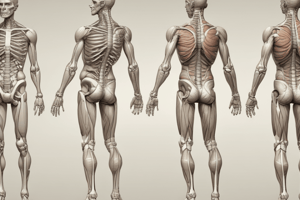Podcast
Questions and Answers
Synovial joints are classified functionally as:
Synovial joints are classified functionally as:
- Diarthroses (correct)
- Amphiarthroses
- Synostoses
- Synarthroses
An immovable joint is a(n):
An immovable joint is a(n):
- Symphysis
- Amphiarthrosis
- Syndesmosis
- Synarthrosis (correct)
- Diarthrosis
A slightly movable joint is a(n):
A slightly movable joint is a(n):
- Gomphosis
- Diarthrosis
- Synostosis
- Synarthrosis
- Amphiarthrosis (correct)
A freely movable joint is a(n):
A freely movable joint is a(n):
A suture is an example of a(n):
A suture is an example of a(n):
Dense connective tissue is to a suture as a periodontal ligament is to a(n):
Dense connective tissue is to a suture as a periodontal ligament is to a(n):
Which of the following is one of the four major types of synarthrotic joints?
Which of the following is one of the four major types of synarthrotic joints?
Joints can be classified structurally as:
Joints can be classified structurally as:
The location where two bones meet is called a joint, or an:
The location where two bones meet is called a joint, or an:
Which bone-associated structure(s) is/are continuous with the capsule of the joint, adding strength and helping to stabilize the joint?
Which bone-associated structure(s) is/are continuous with the capsule of the joint, adding strength and helping to stabilize the joint?
Which of the following is a function of the meniscus?
Which of the following is a function of the meniscus?
Which of the following is not a function of synovial fluid?
Which of the following is not a function of synovial fluid?
Which of the following is not a characteristic of articular cartilage?
Which of the following is not a characteristic of articular cartilage?
The surface of articular cartilage is:
The surface of articular cartilage is:
Which of the following is not a property of synovial joints?
Which of the following is not a property of synovial joints?
Small pockets of synovial fluid that reduce friction and act as a shock absorber where ligaments and tendons rub against other tissues are called:
Small pockets of synovial fluid that reduce friction and act as a shock absorber where ligaments and tendons rub against other tissues are called:
The first carpometacarpal joints are examples of which type of synovial joints?
The first carpometacarpal joints are examples of which type of synovial joints?
The elbow joint is an example of a ________ joint.
The elbow joint is an example of a ________ joint.
Which type of joint is found between the carpal bones?
Which type of joint is found between the carpal bones?
The joint that permits the greatest range of mobility of any joint in the body is the ________ joint.
The joint that permits the greatest range of mobility of any joint in the body is the ________ joint.
All of the following are structural classifications of synovial joints except:
All of the following are structural classifications of synovial joints except:
Which of the following is an example of a ball-and-socket joint?
Which of the following is an example of a ball-and-socket joint?
A joint that permits only flexion and extension is a ________ joint.
A joint that permits only flexion and extension is a ________ joint.
Abduction is a(n):
Abduction is a(n):
Flashcards are hidden until you start studying
Study Notes
Joint Classifications
- Synovial joints are functionally classified as diarthroses.
- An immovable joint is called a synarthrosis.
- A slightly movable joint is designated as amphiarthrosis.
- A freely movable joint is termed diarthrosis.
Joint Examples and Types
- Sutures are specific examples of synarthroses.
- Dense connective tissue in sutures corresponds to the periodontal ligament in gomphosis.
- Four major types of synarthrotic joints include sutures, synchondroses, synostoses, and gomphoses.
- Joints can be structurally categorized as synovial, bony, fibrous, or cartilaginous.
Joint Anatomy
- The location where two bones meet is referred to as an articulation.
- The periosteum is continuous with the joint capsule, enhancing joint stability.
- The meniscus channels synovial fluid flow and provides mechanical support.
Synovial Fluid Characteristics
- Synovial fluid provides nutrients, shock absorption, lubrication, and protects articular cartilages.
- Increasing osmotic pressure within the joint is not a function of synovial fluid.
Articular Cartilage Properties
- Articular cartilage surfaces are smooth and slick, composed of hyaline cartilage with a high water content.
- Articular cartilage does not secrete synovial fluid.
Joint Structure and Movement
- Synovial joints contain synovial fluid, are reinforced by accessory structures, and are covered by a capsule, but not by a serous membrane.
- Bursae are small pockets of synovial fluid that reduce friction around ligaments and tendons.
Specific Joint Types
- The first carpometacarpal joints represent saddle joints.
- The elbow is classified as a hinge joint.
- Joints between carpal bones are gliding joints.
- The shoulder joint allows for the greatest range of motion of any joint in the body.
Joint Classifications and Movements
- Rolling is not a recognized structural classification of synovial joints.
- The shoulder is an example of a ball-and-socket joint.
- Hinge joints allow only flexion and extension.
Movement Definitions
- Abduction refers to movement away from the body's longitudinal axis in the frontal plane.
Studying That Suits You
Use AI to generate personalized quizzes and flashcards to suit your learning preferences.




